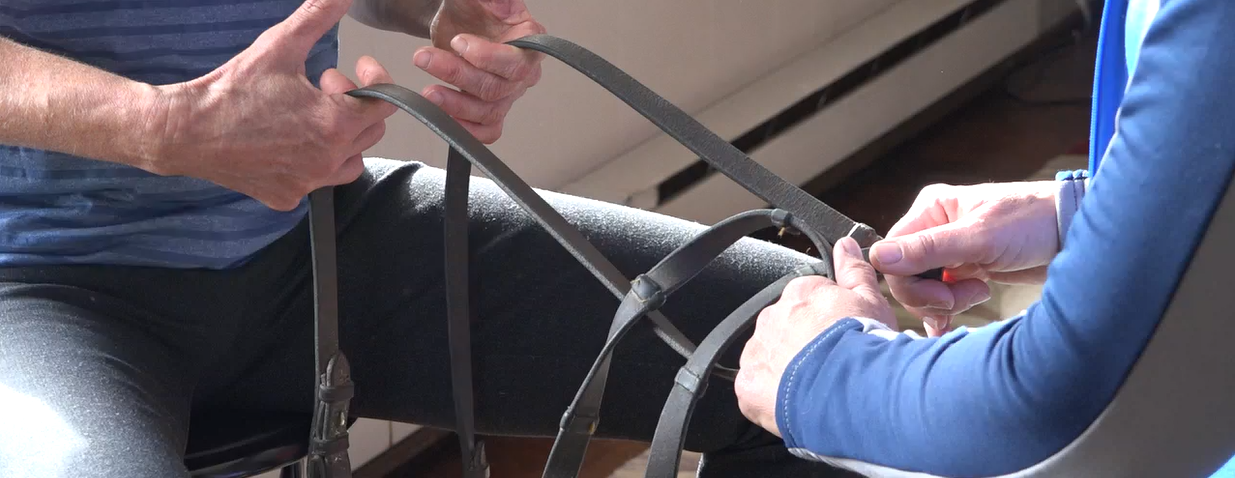Posts in Category: Self Use


The Secret to Soft Hands is in Your Back
As riders, we want to develop soft, steady hands that don’t interfere with the horse’s movement. Many riders try to release the tension in their arms and hands, only to find they are right back to pulling or hanging on the reins, however slight, when their horse runs into the slightest difficulty.
What if I were to tell you the secret to improving your hands does not come from your hands or even your elbows following your horse’s movements, but in how you use your back? You can communicate through your seat without changing anything in your arms, hands or fingers-keeping your shoulders, arms and hands soft!
Let me tell you how I figured this out.
Jeff Haller, a trainer of the Feldenkrais Method, studied directly with Dr. Moshe Feldenkrais, tells the story where Dr. Feldenkrais mentioned that he (Moshe) was able to lift a person’s head without increasing the tone of his hands. Jeff then set out to determine how Moshe was able to have such refined control.
My own experience, many years ago, included Jean Luc Cornille, informing me that he does not “close his hands on the reins,” but rather “changes the tone in his back.” His hands remained, “like shock absorbers.”
I felt these two experiences were related and I had to uncover what each had in common, so a rider can figure out how to use her seat to communicate with the horse, yet maintain a light, contact with soft hands.
One of the fundamental principles of the Feldenkrais Method is the use of a counter-balance or “equal and opposite” for ideal functioning. Let’s say your horse has a loss of balance and increases the weight on the reins. Most riders close their hands on the reins to help the horse rebalance. Closing your fingers on the reins increases the tone within the hands. If instead, you lengthen your spine. This action creates an equal and opposite force by “deepening” your seat, sending your seat bones back and down. This movement is felt by the horse. (And if you have been coming to my workshops or ridden with me, you most likely have experienced it yourself and have sensed for yourself the improvement in the quality of the contact.) There is no need to close your fingers on the reins.
Now my experience has shown that riders need to dedicate themselves to developing this skill. This is not a quick fix. Our awareness and usage of our hands is our default method of operation. Finding the coordination and switching our functioning towards the use of our back takes commitment. Be up for the challenge and dedicate how changing your movement will improve the quality of your contact. Your horse will experience you in a different, much softer, way.
How You Move is Important
Your self-use is an important component in riding and training. It is important to expand your awareness to that of your horse, otherwise, your focus will be limited and self-indulgent. The kinesthetic sense you develop “when you know what you are doing” (Moshe Feldenkrais) and how the horse and rider move together will provide the basis for subtle but clear communication between both, so “you can do what you want.” (Moshe Feldenkrais).
Too much tension or force will interfere with how you sense your horse. When we use too much of our musculature to move we move with tension. We are contradicting ourselves. We end up getting in our own way and interfering with the way we perceive ourselves and our horse. Using your whole self in an efficient manner will impact how your horse senses you. This is achieved through the use of the larger muscles of your back and pelvis synchronized in a specific way to support the actions of your arms and legs. Combined with how we sit on our horse, the use of the larger muscles are more efficient and produce inviting and clearer aids for your horse. Instead of focusing on the specific goals of “leg goes here, back works this way, etc.” you will seamlessly discover your innate ability to synchronize your movements and aid to effectively communicate-your actions become part of the process rather than the seemingly endless quest for a goal.
Your ability to feel and recognize the subtle changes in your horse as he processes your request(s) will be part of this process and will produce a situation for optimal learning. You are much more able to be in the moment to reward or encourage appropriately.
Recent Comments